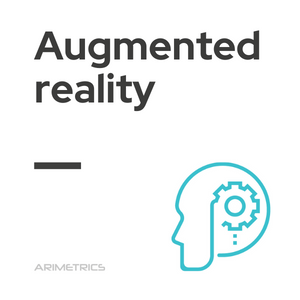 Definition:
Definition:
Augmented reality (abbreviated as AR) is a type of technology that combines elements of the real world with computer-generated information, creating a composite view for the user. Through an augmented reality system, a virtual scene is superimposed on the real scene the user is observing, adding additional information that enriches the user’s perception of the environment.
Augmented Reality Applications
Augmented reality is used in a variety of fields, including:
- Entertainment: Games and applications that integrate virtual elements into the real environment.
- Digital marketingTools that allow consumers to interact with products in an innovative way.
- Military training: Simulations that enhance the training of soldiers in a controlled environment.
- Engineering design: Visualization of models and prototypes in the context of the real world.
- Robotics: Improving human-robot interaction by overlaying useful information in real time.
- Other industries: AR also finds applications in medicine, education, tourism and more.
Examples of AR
Augmented reality is used in a variety of applications and industries. Here are some examples:
- Google Maps uses augmented reality to overlay addresses and points of interest in the real environment through the device’s camera.
- Pokémon GO is a popular augmented reality game that allows players to capture virtual creatures in the real world using their mobile devices.
- IKEA has developed applications that allow users to visualize how furniture would look in their home before buying it.
- Google Lens is a tool that uses augmented reality to identify objects, translate text and provide information about what is being viewed through the device’s camera.
- Snapchat uses augmented reality filters that allow users to add virtual effects to their photos and videos, such as dog ears or virtual makeup.
- Assemblr allows users to create 3D content and then view it in augmented reality through their mobile devices.
- Microsoft HoloLens allows users to interact with holograms in their real environment, used in design, education and medical applications.
Advantages of Augmented Reality
Augmented reality offers a number of advantages in multiple sectors. Some of them are presented below:
- Improved user experience: Augmented reality provides more immersive and engaging interactions, which can increase user satisfaction.
- Contextual information: Allows overlaying relevant information in real time, improving decision making by providing additional data at the right time.
- Training and education: Facilitates hands-on learning and training through interactive simulations that allow users to practice in a safe environment.
- Increased efficiency: In industrial environments, augmented reality can provide visual instructions that help workers complete tasks faster and with fewer errors.
- Innovative marketing: Brands can create more effective and memorable marketing campaigns by offering interactive experiences that capture consumer attention.
- Improved accessibility: Augmented reality can make information more accessible to people with disabilities by providing visual and auditory descriptions that improve comprehension.
